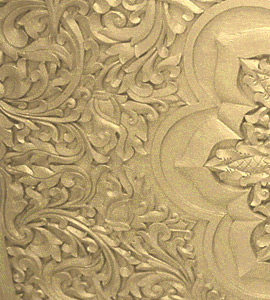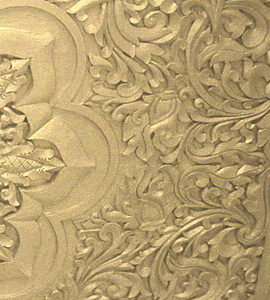


Mission of the Global Vipassana Pagoda
Araddhaviriye pahitatte, niccam dalhaparakkame. Samagge savake passa, etam buddhanavandanam.
"I see meditators all together, steadfast, resolute, always exerting strong effort; this is the proper way to pay homage to the Buddhas."
—Mahapajapatigotamitheriapadanam-2/7-171
The Buddha did not teach Buddhism. He did not convert a single person to Buddhism. This might sound surprising, because of centuries of misconceptions. But the historical truth is that the Buddha neither taught Buddhism nor made any person a Buddhist.
Those to whom the Buddha taught the Dhamma thoroughly were sent to teach others with only the noble volition of "bahujana hitaya bahujana sukhaya lokanukampaya" - For the good of many, for the happiness of many, out of compassion for the world. Instead of establishing a religious sect he re-established the ancient true eternal Dhamma in its pristine purity.
The Vipassana Research Institute (VRI) in Dhamma Giri, Igatpuri, has produced a CD-ROM containing the entire teaching of the Buddha and related literature in Pali. This vast literature contains 146 volumes with 52,602 pages and 7,448,248 words. With the CD-search facility of every word in this vast teaching, we find that the word "Bauddh” has not been used either in his teachings or in that of his followers.
The word used for the teaching of the Buddha is "Dhamma", not "Buddhist Dhamma". Whenever any adjective precedes the word "Dhamma", it is qualitative, not sectarian. Like saddhamma - true Dhamma, ariyo dhammo - noble Dhamma, dhammo sanantano - eternal Dhamma, and so on. His followers were not called Buddhists anywhere in the texts. For those who gained benefit by walking on the path shown by him, these six words were used: dhammim, dhammiko, dhammattho, dhammacarim, dhammavihari, dhammanusari.
Not only during the lifetime of the Buddha but even in the next few centuries, we do not come across words like "Buddhist" or "Buddhism" anywhere.
About 250 years after the Buddha, Emperor Ashoka, who was obsessed with power and was proud to be called "Ashoka the Cruel", came in contact with Dhamma. He benefited, inspired others to walk on the path of Dhamma and he was called "Dhamma Ashoka", not "Buddhist Ashoka".
Out of love for his subjects Emperor Ashoka encouraged the spread of Dhamma among them, not Buddhism. He sent not Buddhism, but the Dhamma ratana - the jewel of Dhamma, not only to neighbouring countries but to distant Western countries as well, as a priceless gift from India. He sent Dhammaduta - Messengers of Dhamma, not "Messengers of Buddhism". None of the edicts on rocks and columns of Emperor Ashoka that have come to light so far contain the word "Buddhist"; everywhere, the word "Dhamma" is used. Dhamma is universal, it is for everyone.
Sectarian words may have come into use to describe the Buddha’s teaching after this country forgot the essence of the true teaching of the Buddha. Gradually this country also lost the entire original related literature and, worst of all, lost Vipassana, the technique of practicing the essence of that teaching.
Vipassana is a very ancient meditation technique of India. Any person who becomes a Buddha attains enlightenment by rediscovering this lost technique. In the Vedic literature before the lifetime of the Buddha there is abundant praise for this technique. But it is only praise. The Buddha re-discovered this lost technique.
Vipassana, the practical aspect of the Buddha’s teaching, serves people from every caste, race, class and religion. It is direct proof that the Buddha’s teaching is universal. When Vipassana was lost the original teaching of the Buddha was lost. This was a great loss not only for our country, but also for all humanity. India lost the beneficial technique due to which its past had been very prosperous and the world had saluted it as a vishwa-guru - Teacher of the world.
With the loss of Vipassana most people forgot the universal and eternal importance of the Buddha’s teaching. As long as it was "Dhamma", people practiced it but as soon as it began to be called "Buddhism", the delusion naturally spread, "This is the Dhamma for Buddhists, not for us". And the immense benefits to be gained from Vipassana were lost.
Fortunately the neighbouring country of Myanmar preserved this universal technique of Vipassana in its pure form for centuries, from generation to generation. It has returned to India and arisen again in the world. This Global Vipassana Pagoda is a symbol of the arising of the Buddha’s true teachings.
This huge stone monument will be a light-house of India’s ancient prosperity and prestige. It will again bring to light the ancient, eternal, universal tradition of Dhamma for the benefit of the world. This golden pagoda will herald the second coming of that golden age when India was the leader not only in the field of spirituality but also in material prosperity.
Adjacent to the Global Vipassana Pagoda, a Vipassana center is being built to enable holding of residential 10-day courses, as in 130 Vipassana centers worldwide.
A state-of-the art exhibition gallery will convey information about Vipassana, and will depict various well-known, inspiring incidents in the life of the Buddha and his disciples, showing how this universal, non-sectarian teaching enables one to live a life full of compassion, equanimity and practical wisdom to deal with all the challenging ups and downs in life.
Visitors will come to learn that Sakyamuni Gotama Buddha was neither a god, nor an incarnation of any god, nor a prophet of any god. He was not a mythological being but a historical person. He did not become the Buddha - the highest state that can be attained by a human being - because of divine grace, but by exerting strenuous efforts for innumerable lives. He attained supreme enlightenment in his final life and therefore was called a Sammasambuddha - one who becomes a Buddha by his own efforts.
The Buddha was called the All-Compassionate One because, out of infinite compassion and despite many hardships and challenges he faced in his life, he taught Vipassana for liberation from suffering. He completely eradicated craving, aversion and ignorance, and so was called Bhagava. He re-discovered and taught the natural law of cause and effect.
If the true qualities of the historical Buddha come to light, misconceptions about him will be removed and the importance of human effort and valour will be established in place of blind belief in divine miracles. The Global Vipassana Pagoda will help remove such misconceptions about the Buddha.
Another important aspect about the Global Vipassana Pagoda will be that the sacred relics of the physical body of the Buddha will be enshrined within. These sacred relics were received from the Maha Bodhi Society and from Sri Lanka.
Usually such pagodas are solid. But using the most modern techniques of architecture this vast meditation hall has been built within so that over 8,000 Vipassana students can benefit from meditating together. There are thousands of Vipassana meditators in Mumbai itself. This number is increasing day-by-day and it will continue to do so in the future.
We express our gratitude towards Myanmar. For centuries, people of this country who see this pagoda will remember the kindness of that country with gratitude. With the arising of this feeling of gratitude, their Dhamma volition will be strengthened. Thus the building of this Global Vipassana Pagoda, a replica of the Shwe Dagon pagoda in Yangon (Rangoon), will be meaningful. The people of this country will become happy, become peaceful.

